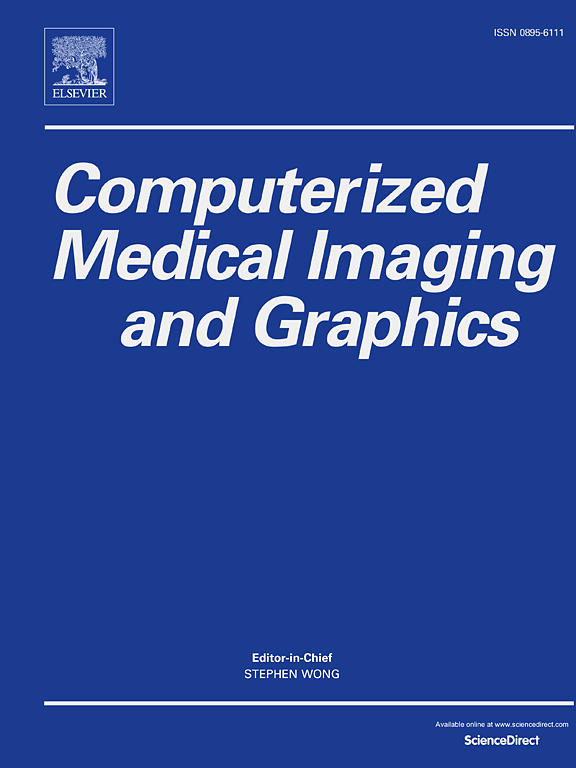Domain adaptive detection framework for multi-center bone tumor detection on radiographs
IF 4.9
2区 医学
Q1 ENGINEERING, BIOMEDICAL
Computerized Medical Imaging and Graphics
Pub Date : 2025-03-07
DOI:10.1016/j.compmedimag.2025.102522
引用次数: 0
Abstract
Automatic bone tumor detection on radiographs is crucial for reducing mortality from bone cancer. However, the performance of the detection methods may be considerably affected when deployed to bone tumor data in a distinct domain, which could be attributed to the differences in the imaging process and can be solved by training with a large amount of annotated data. However, these data are difficult to obtain in clinical practice. To address this challenge, we propose a domain-adaptive (DA) detection framework to effectively bridge the domain gap of bone tumor radiographs across centers, consisting of four parts: a multilevel feature alignment module (MFAM) for image-level alignment, Wasserstein distance critic (WDC) for quantization of feature distance, instance feature alignment module (IFAM) for instance-level alignment, and consistency regularization module (CRM), which maintains the consistency between the domain predictions of MFAM and IFAM. The experimental results indicated that our framework can improve average precision (AP) with an intersection over union threshold of 0.2 (AP@20) on the source and target domain test sets by 1 % and 8.9 %, respectively. Moreover, we designed a domain discriminator with an attention mechanism to improve the efficiency and performance of the domain-adaptative bone tumor detection model, which further improved the AP@20 on the source and target domain test sets by 2 % and 10.7 %, respectively. The proposed DA model is expected to bridge the domain gap and address the generalization problem across multiple centers.
x线片上多中心骨肿瘤检测的域自适应检测框架
骨肿瘤在x线片上的自动检测对于降低骨癌死亡率至关重要。然而,当部署到不同领域的骨肿瘤数据时,检测方法的性能可能会受到很大影响,这可能是由于成像过程的差异,可以通过使用大量注释数据进行训练来解决。然而,这些数据在临床实践中很难获得。为了解决这一挑战,我们提出了一个域自适应(DA)检测框架,以有效地弥合骨肿瘤x线片跨中心的域间隙,包括四个部分:用于图像级对齐的多层特征对齐模块(MFAM),用于特征距离量化的Wasserstein距离批判模块(WDC),用于实例级对齐的实例特征对齐模块(IFAM),以及用于保持MFAM和IFAM领域预测之间一致性的一致性正则化模块(CRM)。实验结果表明,该框架可将源域和目标域测试集上相交于联合阈值为0.2 (AP@20)的平均精度(AP)分别提高1 %和8.9 %。此外,我们设计了一个具有关注机制的领域鉴别器,提高了领域自适应骨肿瘤检测模型的效率和性能,进一步提高了源域和目标域测试集上的AP@20分别提高了2 %和10.7 %。所提出的数据分析模型有望弥合领域差距并解决跨多中心的泛化问题。
本文章由计算机程序翻译,如有差异,请以英文原文为准。
求助全文
约1分钟内获得全文
求助全文
来源期刊
CiteScore
10.70
自引率
3.50%
发文量
71
审稿时长
26 days
期刊介绍:
The purpose of the journal Computerized Medical Imaging and Graphics is to act as a source for the exchange of research results concerning algorithmic advances, development, and application of digital imaging in disease detection, diagnosis, intervention, prevention, precision medicine, and population health. Included in the journal will be articles on novel computerized imaging or visualization techniques, including artificial intelligence and machine learning, augmented reality for surgical planning and guidance, big biomedical data visualization, computer-aided diagnosis, computerized-robotic surgery, image-guided therapy, imaging scanning and reconstruction, mobile and tele-imaging, radiomics, and imaging integration and modeling with other information relevant to digital health. The types of biomedical imaging include: magnetic resonance, computed tomography, ultrasound, nuclear medicine, X-ray, microwave, optical and multi-photon microscopy, video and sensory imaging, and the convergence of biomedical images with other non-imaging datasets.

 求助内容:
求助内容: 应助结果提醒方式:
应助结果提醒方式:


